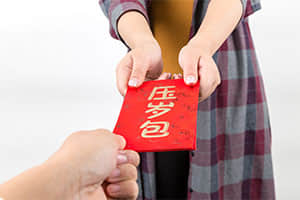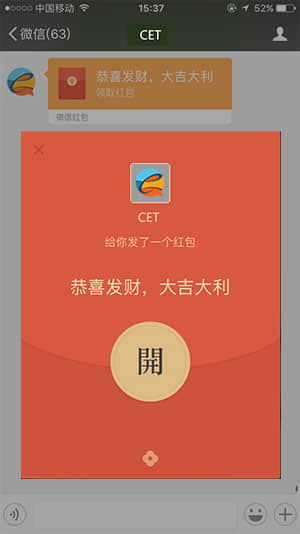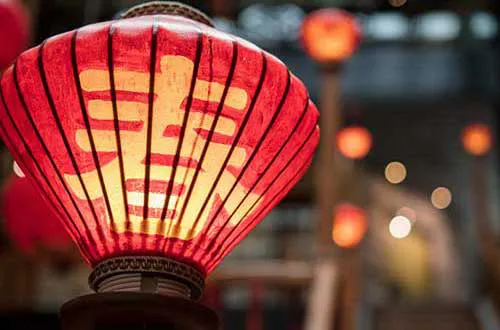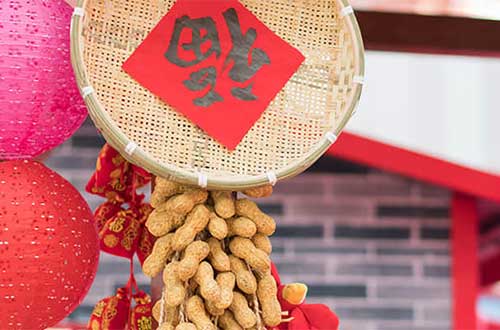Chinese Red Envelopes (红包 hóng bāo Lucky Money)

Lucky money comes from the ancient “copper cash” (round coins with a square hole that were made of copper), which was used for practicing sorcery before . With times changing, lucky money has become the form of cash wrapped in red envelopes, which symbolizes good luck and blessing.
What is Red Envelope Called in Chinese?
Red Envelopes are a traditional gift presented in festivals or special occasions, like Chinese New Year or weddings . In China, we call lucky money "hongbao" (红包 | 紅包 hóng bāo) in Mandarin or "lilai see" (利是 lai6 si6) in Cantonese . We also call it "ya sui qian," (压岁钱 | 壓歲錢 yā suì qián) in Chinese New Year, which translates to "lucky money" or "New Year's money".
During the Chinese New Year, red envelopes are also referred to as "ya sui qian," (压岁钱 | 壓歲錢 yā suì qián) which translates to "lucky money" or "New Year's money."
Why do the Chinese give red envelopes: the Origin of Red Envelopes

Red envelopes come from ancient exorcisms. In ancient times, people believed that the color of red can keep evil away and prevent disasters. So people put coins in red paper bags, hung them on doors, or carried them to pray for safety when they were outside. Now, people put coins, gold, or silver into red envelopes as a blessing and New Year's gift for the younger generation and give them to younger generations.
In addition, red envelopes are also related to seasonal rituals and the accumulation of wealth. During important festivals like the lunar New Year, people hold ritual ceremonies to pray for a bountiful harvest and the prosperity of their families. Now, elders put coins into red envelopes as a blessing and New Year's gift for the younger generation. This tradition has become a way for friends and family to express blessings.
What is the significance of giving red envelopes?
Red envelopes, as a unique form of Chinese traditional culture, carry rich cultural connotations and social significance, making them an indispensable part of Chinese culture.
Blessings and Good Luck
Red envelopes are all about blessings and good luck. When we give red envelopes to family and friends during festive occasions like the Chinese New Year, the primary purpose is to bring them good fortune and happiness. Each red envelope holds our warmest wishes for people who got it, hoping for their safety, health, and smooth journey in the coming year.
Celebration and Joy
Red envelopes also symbolize celebration and joy . In Chinese traditional culture, red envelopes are usually used in some celebrations and special occasions such as weddings, birthdays, or academic achievements . Giving a red envelope is more than just a gift; it’s about adding a festive atmosphere and allowing people to share in the joyous celebration .
Family Ties and Care
Red envelopes bring people closer and strengthening relationships. In Chinese family culture, elders give red envelopes to younger family members to express love and blessings.People give red envelopes to friends and colleagues to express friendship and care.
Social Interaction and Etiquette
Red envelopes are a way to enhance social interaction. In Chinese society, there are certain manners and customs associated with the giving and receiving of red envelopes. Giving red envelopes in appropriate situations expresses respect and politeness, fostering deeper relationships. Simultaneously, recipients often express gratitude in an appropriate manner, showcasing social etiquette.
Business Etiquette
In business settings, red envelopes are often used as a gift or tip to express respect and gratitude. Despite the diverse payment methods in modern society, red envelopes are important for business etiquette, signifying appreciation and courtesy.
Red Envelopes for Chinese New Year
Presenting red envelopes during the New Year is significant in Chinese traditional culture, and it means conveying blessings. The following will give you a detailed introduction to the etiquette of the Chinese New Year's red envelopes, helping you better express the blessing.
1, When are red envelopes given during Chinese New Year?
During the Chinese New Year, parents, grandparents, and other elders often give red packets to children on New Year's Eve or the morning of the first day of the year to welcome the new year and convey blessings and joy.
Friends and relatives typically exchange red envelopes when visiting each other during the New Year period. Of course, according to the actual situation and personal habits, you can also choose other appropriate time to give red envelopes.
2, How much should be given in the Chinese New Year's red envelope?
Lucky money, for the elder, is looking forward to the children’s sound health; for the young, it implies an expression of blessing. The amount in the red envelope varies from tens to thousands of Yuan. The more intimate the relationship is, the more valuable the red envelope is likely to be. Naturally it depends on their personal economic situation, and the main idea is simply to add joy to the festival.
Regional differences in red packet amounts exist; for example, in Guangdong, the quantity of red packets may be emphasized, generally do not care about the amount of red envelopes, red envelopes may be 6 yuan, 8 yuan, a little more may be 66 yuan, 88 yuan, the amount in a red envelope is usually some auspicious numbers. In Jiangsu, the amount of red envelopes is based on their own reality, but a red envelope inside the minimum is 100 yuan.
3, Using Red Paper Bags
It is preferable to put your cash into red paper bags. Red symbolizes auspiciousness, joy, and good luck in Chinese culture, and placing cash in a red paper bags enhances the expression of blessings and joy. You can also write some blessing phrases on the back of red envelopes to add extra meaning.
4,Hand-Delivery
Hand delivering red envelopes is a way to show your respect and care to others. It is also a very important part of the Chinese New Year. Sometimes we also give red envelopes by WeChat or Alipay, but hand-delivered red envelopes are still the best way to express respect.
5, Well-Wishing Expressions
When giving red envelopes, you can say some New Year's blessings. For younger generation at work, one might say, "May your work go smoothly and all your wishes come true". For children, you can say "May you grow happily and succeed in your studies". For elders, phrases like "Wishing you health and longevity" are commonly used. The words of blessing can convey your sincere blessing and make the red envelope more meaningful.
Red Envelopes for Birthday
It's common to give red envelopes in birthdays of family members, friends, or couples. With the convenience of smartphones, sending red envelopes has become easier. But how much is appropriate for a birthday red envelope? Here are some suggestions:
For Couples' Birthday Red Envelopes
For couples, you can send amounts with special meanings, such as "520" which means "I love you" and "1314" means "forever". If that’s too much, you can choose 13.14 instead.
For Close Relatives' Birthday Red Envelopes
For parents, close relatives, and close friends, you can choose the amount of birthday red envelopes like 200 or more, with parents usually receiving 600 or more . For more significant birthdays, you can adjust the amount depending on your financial situation.
For Regular Friends' Birthday Red Envelopes
For friends who are not very close, it’s okay to give a bit less—several yuan . Choose a red envelope with a lucky number, such as 6, 8. 6 symbolizes everything goes well, and 8 represents wealth or prosperity.
Red Envelopes for Wedding
We usually express our blessings for families or friends by giving red envelopes. We should think about those questions when we are giving wedding red envelopes:
How much do you need to give for the wedding red envelope?
For friends with regular relationships, an amount of 100 or 200 yuan would be okay. For closer relationships, an amount of 300 yuan or more will be better. You can give red envelopes based on the closeness of the relationship and your own financial situation.
Appearance of the Wedding Red Envelope
You can use red envelopes that say "Happy Wedding" or "Wishing You a Hundred Years of Happiness" . You can also add your own personal wishes. You should write your name on the back of the red envelope , so it’s clear who it is from.
Timing of Delivering the Wedding Red Envelope
Delivering the wedding red envelope on time is important. You can bring it to the wedding or drop it off before the wedding. If you want to give it early, it's best to give it within a week before the wedding, so the couple can get the blessings on time.
Alipay and WeChat Red Envelope

Moving on from the traditional red envelope, there is a new way which is far more appealing for smart phone users, and that is using apps such as Alipay, WeChat and the Weibo Red Envelope. Digital red envelopes especially offer excitement and value on the Eve of Lunar New Year, as users can win red envelopes by shaking their smart phones during the time that the Gala is being televised.
Tips about lucky money:
1. Please don’t open red envelopes on the spot, because it is impolite.
2. We call lucky money "lai see" 利是 in Cantonese speaking areas.
3. Pick a lucky number as the amount for the red envelope. In Chinese culture, good things come in pairs, so we usually wrap cash in red envelopes with a favorable number,like 666,888. But the number four is an exception, because it sounds like the word for “death” in the Chinese language.
4. The amount of lucky money is usually an integer; people like to exchange the money with consecutive numbers which means that they wish others to get promotion at every step.
5. If you want to give a large amount in a red packet, you may as well change some new 100-yuan notes.
6. Say “Best wishes for the New Year!” when you give lucky money.
7. People like to exchange some new cash to put in the red envelopes, so there is always a long line in the bank before New Year’s arrival.
8. Can red envelopes be recycled? Following the principle of not wasting, you can reuse some beautiful and not damaged red envelopes next year. But you should pay attention to the red envelopes with different blessings, for they only can be used in certain contexts. Moreover, some regions may have taboos against using old red envelopes.
OR
Are you eager to begin your Chinese cultural journey?
Drop us a line and we will promptly connect you with our leading China expert!
 Customs of Chinese New Year
Customs of Chinese New Year  Chinese New Year
Chinese New Year  Chinese New Year Gift Ideas
Chinese New Year Gift Ideas  Chinese New Year Taboos
Chinese New Year Taboos